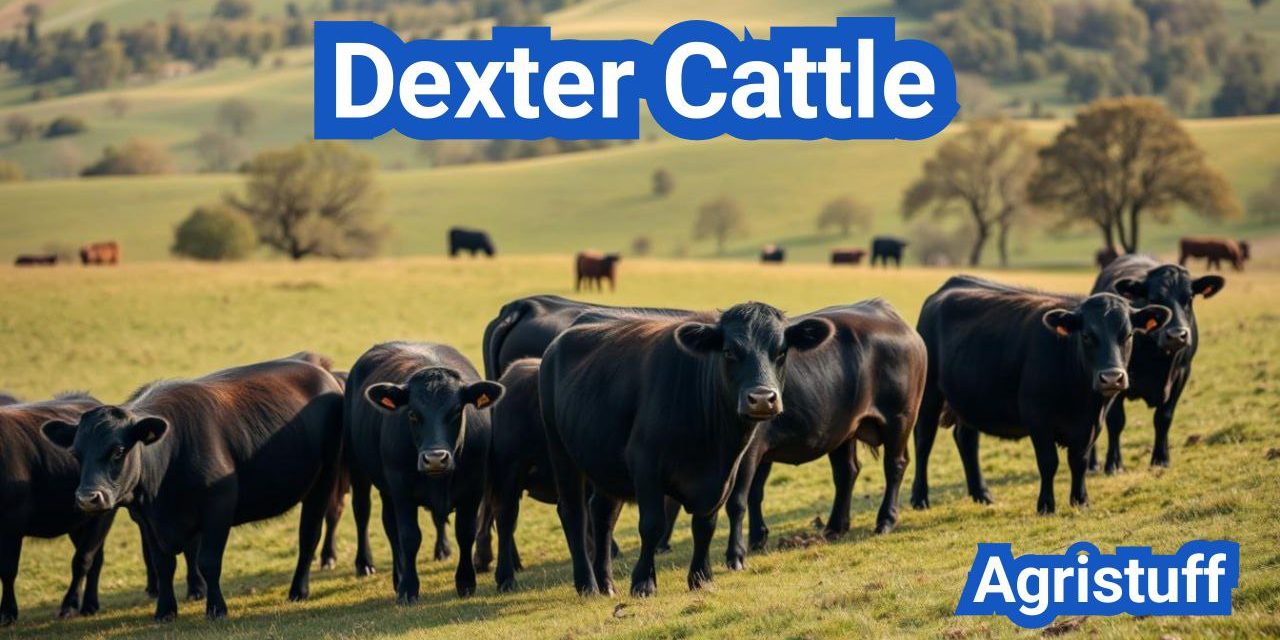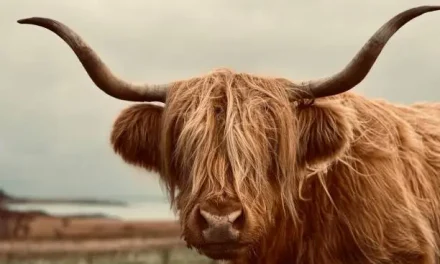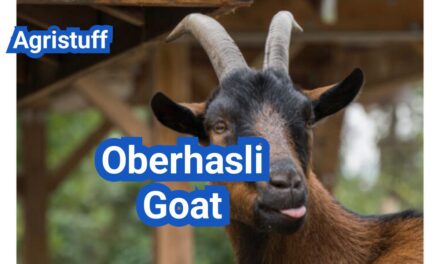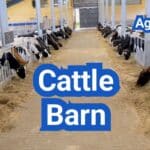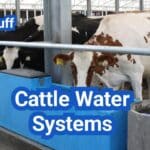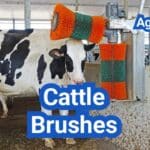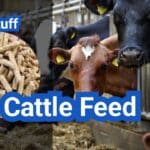Originating from Ireland in the early 1800s, Dexter cattle are a heritage breed known for their compact size and robust characteristics. These small cattle breeds were imported to North America around 1910 and have since become a popular choice for livestock farming due to their dual-purpose nature.
With their rich history and unique characteristics, Dexter cattle are an excellent choice for farmers looking for a heritage cattle breed that can thrive in various environments. Their compact size and weight make them an ideal choice for small farms or homesteads.
Key Takeaways
- Dexter cattle are a compact heritage breed originating from Ireland.
- They were imported to North America around 1910.
- Dexter cattle are a dual-purpose breed, suitable for various farming needs.
- Their small size makes them ideal for small farms or homesteads.
- Dexter cattle have a rich history and robust characteristics.
The History and Origin of Dexter Cattle
The Dexter cattle breed has a rich and fascinating history that dates back to the early 19th century in southern Ireland. This heritage breed was developed from the native cattle of Ireland, known for their hardiness and adaptability to the rugged local climate.
Irish Roots and Heritage
The story of Dexter cattle begins in the lush landscapes of southern Ireland, where they were first bred. The breed is believed to have descended from the Kerry cattle, another Irish breed known for its robustness. The name ‘Dexter’ is thought to be associated with a Mr. Dexter, an estate manager who played a significant role in the breed’s development.
The harsh Irish climate and the need for a versatile, hardy animal drove the selection process. Farmers sought cattle that could thrive on limited feed, provide milk and meat, and withstand the local weather conditions. This selective breeding resulted in the Dexter cattle we know today.
Development of the Breed
Over time, Dexter cattle became renowned for their dual-purpose qualities, offering both milk and meat. Their compact size made them ideal for small farms, where they could be used for a variety of tasks. The breed’s development was influenced by the local farming practices and the economic need for a low-maintenance, productive animal.
As the breed evolved, so did its popularity. By the late 19th century, Dexter cattle had gained recognition not only in Ireland but also in other parts of the world, including the United Kingdom.
Dexter Cattle in America
The introduction of Dexter cattle to America marked a new chapter in the breed’s history. The first recorded importation of Dexter cattle to the United States occurred around 1905. American farmers were attracted to the breed’s hardiness, versatility, and the quality of its milk and meat.
Today, Dexter cattle are cherished in America for their heritage value and their suitability for small-scale, sustainable farming practices. They are recognized by various cattle registries, including the American Dexter Cattle Association, which works to preserve the breed’s integrity and promote its benefits.
| Year | Event | Location |
|---|---|---|
| Early 1800s | Origin of Dexter Cattle | Southern Ireland |
| Late 1800s | Recognition in the UK | United Kingdom |
| 1905 | First Importation to the US | United States |
“The Dexter breed is a shining example of heritage cattle farming, offering a unique blend of history, hardiness, and productivity.”
— Dexter Cattle Association
Understanding Dexter Cattle Characteristics

Dexter cattle are a heritage breed that boasts several notable characteristics, including their physical appearance and longevity. Their compact size, hardiness, and versatility make them an attractive choice for many farmers.
Physical Appearance and Size
Dexter cattle are known for their compact size, with cows typically weighing between 600-800 pounds and standing between 34-46 inches tall. Their small stature makes them ideal for small-acreage farms. Their physical appearance is characterized by a sturdy build and a robust constitution, allowing them to thrive in various conditions.
Weight and Growth Patterns
The weight of Dexter cattle is an important characteristic, with adults typically ranging from 600 to 1000 pounds, depending on factors like genetics and nutrition. Growth patterns in Dexter cattle are relatively slow compared to larger breeds, but this slow growth contributes to their hardiness and the quality of their meat.
- Mature cows weigh between 600-800 pounds.
- Bulls can weigh up to 1000 pounds.
- Growth rates are moderate, supporting the development of high-quality beef.
Temperament and Behavior
Dexter cattle are known for their docile temperament, making them easy to handle, even for inexperienced farmers. Their calm nature is a significant advantage, as it reduces stress for both the animals and the farmer.
Key aspects of their temperament and behavior include:
- Generally docile and easy to manage.
- Can be quite friendly and interactive.
- Require careful handling to maintain their trust.
Longevity and Health Traits
Dexter cattle are renowned for their longevity and hardiness. They are a long-lived breed, often producing calves well into their teens. Their health traits include resistance to certain diseases and the ability to thrive on poor-quality forage.
Some key health and longevity traits are:
- Long productive life, often beyond 15 years.
- Resistance to many cattle diseases.
- Ability to adapt to various environmental conditions.
Dexter Cattle Colors and Varieties
Dexter cattle come in a variety of colors, including solid black, red, and dun, each with its own unique charm. This diversity in color adds to the breed’s appeal, making them a visually interesting addition to any farm or ranch.
Black Dexters
Black Dexters are characterized by their deep, rich black coat. They are a popular choice among Dexter breeders due to their striking appearance. The black coloration is a result of a genetic variation that causes the production of excess melanin, giving them their distinctive color.
Red Dexters
Red Dexters range in color from a light red to a deep, rich red. Their color can vary, but they are generally recognized by their reddish hue. Red Dexters are known for their friendly temperament and are often favored for their milk production qualities.
Dun Dexters
Dun Dexters have a unique, primitive appearance characterized by a light tan or gold coat, often accompanied by a darker stripe along their back and dorsal stripe. The dun coloration is a result of a dilution gene that affects the production of melanin, giving them a distinctive look.
Breed Standards and Registration
The American Dexter Cattle Association (ADCA) sets the breed standards for Dexter cattle in the United States. To be registered, Dexters must meet specific criteria regarding their size, conformation, and color. The ADCA maintains the integrity of the breed by ensuring that registered cattle adhere to these standards.
| Color | Description | Characteristics |
|---|---|---|
| Black | Deep, rich black coat | Striking appearance, popular among breeders |
| Red | Ranges from light to deep red | Friendly temperament, known for milk production |
| Dun | Light tan or gold with dorsal stripe | Unique, primitive appearance, dilution gene |
Understanding the different colors and varieties of Dexter cattle is essential for breeders and farmers. Whether you’re drawn to the sleek appearance of black Dexters, the warmth of red Dexters, or the primitive look of dun Dexters, there’s a Dexter to suit every preference.
Why Choose Dexter Cattle for Your Farm

The compact size and versatility of Dexter cattle make them ideal for small farms. These cattle are well-suited for land-limited farming operations due to their small stature and efficient resource utilization.
Perfect for Small Acreage
Dexter cattle are one of the smallest cattle breeds, making them perfect for small-acreage farms. Their compact size means they require less land, less feed, and less overall resources compared to larger breeds.
- Require less land for grazing
- Consume less feed
- Need less space for housing
Dual-Purpose Benefits
Dexter cattle are a dual-purpose breed, providing both high-quality milk and beef. This dual functionality makes them an excellent choice for small-scale farmers looking to diversify their products.
- Rich milk production for dairy needs
- High-quality beef for meat production
Economic Advantages
Raising Dexter cattle can be economically advantageous due to their low maintenance costs and the potential for multiple income streams through milk and meat sales.
- Lower feed and housing costs
- Potential for selling dairy and meat products
- Opportunity for value-added products
Compatibility with Small-Scale Farming
Dexter cattle are highly compatible with small-scale farming practices. Their gentle nature and manageable size make them easy to handle, even for less experienced farmers.
Key benefits include:
- Ease of handling due to their calm temperament
- Less labor-intensive compared to larger cattle breeds
- Flexibility in farming operations
Getting Started with Dexter Cattle
Embarking on the journey of raising Dexter cattle requires careful planning and a thorough understanding of the breed’s specific needs. To successfully start a Dexter cattle farm, one must consider several key factors.
Land Requirements and Fencing
The first step in establishing a Dexter cattle farm is to assess the land available for grazing and housing the cattle. Dexter cattle are known for their ability to thrive on smaller acreages, making them ideal for small farms. However, the quality of the pasture is crucial. Adequate fencing is also essential to ensure the cattle remain contained and safe from predators.
A general rule of thumb is to provide at least one acre of good quality pasture per cow. However, this can vary based on the pasture’s productivity and the cattle’s management system. Rotational grazing can help maximize the use of available pasture.
Initial Investment Costs
Understanding the initial investment required to start a Dexter cattle farm is vital. The costs include purchasing the cattle, fencing, equipment, and initial veterinary care. The cost of Dexter cattle can vary based on factors like age, quality, and breeding potential.
| Item | Estimated Cost | Notes |
|---|---|---|
| Dexter Cattle (per head) | $800 – $1,200 | Costs vary based on age and quality |
| Fencing (per acre) | $300 – $500 | Depends on the type and quality of fencing |
| Equipment (watering, feeding) | $500 – $1,000 | Initial setup costs for equipment |
Essential Equipment and Facilities
In addition to land and fencing, several pieces of equipment are necessary for the successful management of Dexter cattle. These include adequate watering systems, feeding troughs, and shelter for protection against the elements.
Watering systems should be designed to provide clean, fresh water at all times. Feeding troughs should be durable and accessible. Shelter can range from simple structures to more complex barns, depending on the climate and the farmer’s preferences.
Finding and Purchasing Quality Stock
The success of a Dexter cattle operation depends significantly on the quality of the stock. When purchasing Dexter cattle, look for breeders who adhere to breed standards and have a reputation for raising healthy, well-tempered animals.
It’s advisable to visit potential breeders, inspect the conditions, and ask about the health history and breeding practices. Purchasing from reputable sources may cost more upfront but can save on veterinary bills and improve the overall productivity of the farm in the long run.
Proper Care and Management of Dexter Cattle

To ensure the well-being of Dexter cattle, it’s essential to understand their specific care requirements. Dexter cattle are known for their hardiness and adaptability, but like all livestock, they require proper management to thrive.
Feeding Requirements and Nutrition
Dexter cattle are ruminants and have specific dietary needs. Their diet should consist of high-quality hay, grass, and appropriate grains. It’s crucial to provide them with a balanced nutrition plan to maintain their health and productivity.
A feeding regimen for Dexter cattle should include:
- High-quality hay, such as timothy or alfalfa
- Access to fresh grass for grazing
- Grains like corn or oats, especially during lactation or growth periods
- Mineral supplements to ensure they receive all necessary nutrients
It’s also important to monitor their feeding to avoid overfeeding, which can lead to obesity and related health issues.
Shelter Needs Through Seasons
Adequate shelter is vital for protecting Dexter cattle from extreme weather conditions. The shelter should provide:
- Protection from wind, rain, and snow
- Shade during hot summer months
- Ventilation to prevent moisture buildup
Dexter cattle are generally hardy, but extreme weather can still pose risks to their health. Ensuring they have a well-maintained shelter can significantly improve their well-being.
Daily Management Routines
Establishing a daily routine is crucial for the effective management of Dexter cattle. This includes:
- Monitoring their health and behavior daily
- Ensuring access to clean water and adequate nutrition
- Maintaining clean living conditions
- Checking fences and enclosures for any damage
Regular daily checks help in early detection of any health issues or other problems, allowing for timely intervention.
Health Monitoring and Preventative Care
Health monitoring is a critical aspect of managing Dexter cattle. Regular checks should include:
- Observing for signs of illness or injury
- Monitoring reproductive health
- Keeping records of vaccinations and deworming
Preventative care measures, such as vaccinations and parasite control, are essential for maintaining the health of the herd. Regular veterinary check-ups can also help in early detection and treatment of health issues.
| Health Monitoring Activity | Frequency | Purpose |
|---|---|---|
| Visual inspection for signs of illness or injury | Daily | Early detection of health issues |
| Vaccinations | As recommended by a veterinarian | Prevention of diseases |
| Parasite control measures | Regularly, based on parasite load | Prevention of parasite-related health issues |
Breeding Dexter Cattle Successfully

The art of breeding Dexter cattle involves more than just selecting healthy animals; it requires a deep understanding of Dexter genetics and effective breeding techniques. Successful breeding programs are built on a foundation of quality breeding stock, well-planned breeding schedules, and attentive calf care.
Selecting Quality Breeding Stock
Selecting the right breeding stock is crucial for any successful Dexter cattle breeding program. This involves evaluating potential breeding animals based on their genetic lineage, physical characteristics, and health.
- Genetic Lineage: Look for animals with a strong, diverse genetic background to minimize the risk of inherited health issues.
- Physical Characteristics: Breeding stock should conform to the breed standard, exhibiting the characteristic compactness and dual-purpose utility of Dexter cattle.
- Health: Ensure that breeding animals are healthy and free from diseases that could be passed on to their offspring.
Understanding Dexter Genetics
A fundamental understanding of Dexter genetics is essential for making informed breeding decisions. Dexter cattle are known for their unique genetic makeup, which influences their size, hardiness, and productivity.
Key genetic considerations include:
- Size and Scale: Dexters are a compact breed, and their genetics play a significant role in determining their mature size.
- Horned vs. Polled: The genetic trait for being horned or polled is an important consideration for breeders.
- Color Genetics: Dexter cattle come in various colors, including black, red, and dun. Understanding the genetics behind these colors can help breeders achieve their desired outcomes.
Breeding Schedules and Techniques
Developing an effective breeding schedule is critical for the success of a Dexter cattle breeding program. This involves deciding on the optimal breeding season, managing the breeding process, and ensuring that cows are bred at the right time.
Some key considerations for breeding schedules include:
- Breeding Season: Align the breeding season with the farm’s overall management plan and climate conditions.
- Breeding Techniques: Decide between natural breeding and artificial insemination (AI), considering factors like genetic diversity and disease control.
Calving and Calf Care
Calving and calf care are critical components of a successful Dexter cattle breeding program. Ensuring that calves are born healthy and receive proper care is vital for their survival and future productivity.
Best practices for calving and calf care include:
- Monitoring: Keep a close eye on pregnant cows as they approach calving, being prepared to assist if necessary.
- Nutrition: Provide adequate nutrition to calves and their mothers, supporting their health and growth.
- Health Checks: Regularly check calves for signs of illness or distress, and take prompt action if any issues are identified.
Milk Production from Dexter Cows

With their rich milk and compact size, Dexter cows offer a unique opportunity for dairy production on small farms. Dexter cattle are known for their ability to produce high-quality milk, making them an attractive choice for dairy farmers looking to capitalize on the growing demand for specialty dairy products.
Milking Techniques and Equipment
Proper milking techniques are essential for maintaining the health of the cow and the quality of the milk. Dexter cows are generally docile and easy to handle, making the milking process straightforward. Farmers should invest in good quality milking equipment that is designed for small-scale dairy operations. This includes a milking machine or a manual milking system, depending on the size of the operation and the farmer’s preference.
Key considerations for milking equipment include:
- Ease of use and cleaning
- Durability and reliability
- Compatibility with the cow’s anatomy
Milk Yield and Quality
Dexter cows are capable of producing between 1-3 gallons of milk per day, which is a respectable yield considering their small size. The quality of the milk is also noteworthy, with high butterfat content making it ideal for producing rich dairy products like cheese and butter.
The factors influencing milk yield and quality include:
- Nutrition and diet
- Health and wellness of the cow
- Milking frequency and technique
Processing Dexter Milk
Once milked, the milk needs to be processed to maintain its quality and safety. This involves cooling the milk to a suitable temperature, followed by pasteurization or other processing techniques depending on the intended use of the milk. For small-scale farmers, investing in a pasteurizer or partnering with a local dairy processor can be a viable option.
Regulations for Dairy Production
Dairy production is a regulated industry, and farmers must comply with local and national regulations regarding milk production, processing, and distribution. This includes adhering to standards for milk quality, sanitation, and animal welfare. Farmers should familiarize themselves with these regulations to ensure compliance and avoid potential penalties.
Regulatory considerations include:
- Milk quality testing and standards
- Sanitation and hygiene practices
- Record-keeping and reporting requirements
Raising Dexter Cattle for Beef

Raising Dexter cattle for beef is an attractive option for farmers due to their compact size and high-quality meat. Dexter cattle are known for their efficient growth rates and superior beef quality, making them an ideal choice for small-scale farmers.
Growth Rates and Finishing
Dexter cattle are recognized for their rapid growth rates, reaching maturity quickly. This characteristic allows farmers to bring their cattle to market faster, reducing the overall production costs. Finishing techniques, such as grass-feeding, can enhance the quality of the beef, making it more appealing to consumers seeking grass-fed products.
Dexter Beef Quality and Characteristics
Dexter beef is renowned for its tenderness, rich flavor, and fine texture. The meat is often described as having a more intense beef flavor compared to larger breeds. This is attributed to the breed’s genetic makeup and the practice of raising them on pasture.
Butchering Options and Timing
The timing of butchering is crucial for achieving optimal beef quality. Typically, Dexter cattle are ready for butchering between 18 to 24 months of age. Farmers have the option to butcher the cattle themselves or send them to a professional processing facility.
Marketing Your Dexter Beef
Effective marketing strategies are essential for selling Dexter beef. Highlighting the breed’s heritage, the quality of the meat, and the sustainable production methods can attract premium prices. Farmers can target specialty markets, such as restaurants and high-end grocery stores, to capitalize on the demand for unique and high-quality beef products.
| Aspect | Description | Benefits |
|---|---|---|
| Growth Rate | Rapid growth to maturity | Reduced production costs, faster market readiness |
| Beef Quality | Tender, rich flavor, fine texture | Premium product, attractive to specialty markets |
| Finishing Techniques | Grass-feeding | Enhanced beef quality, appeals to consumers seeking grass-fed products |
| Butchering Timing | Between 18 to 24 months | Optimal beef quality, readiness for market |
Sustainable Farming with Dexter Cattle
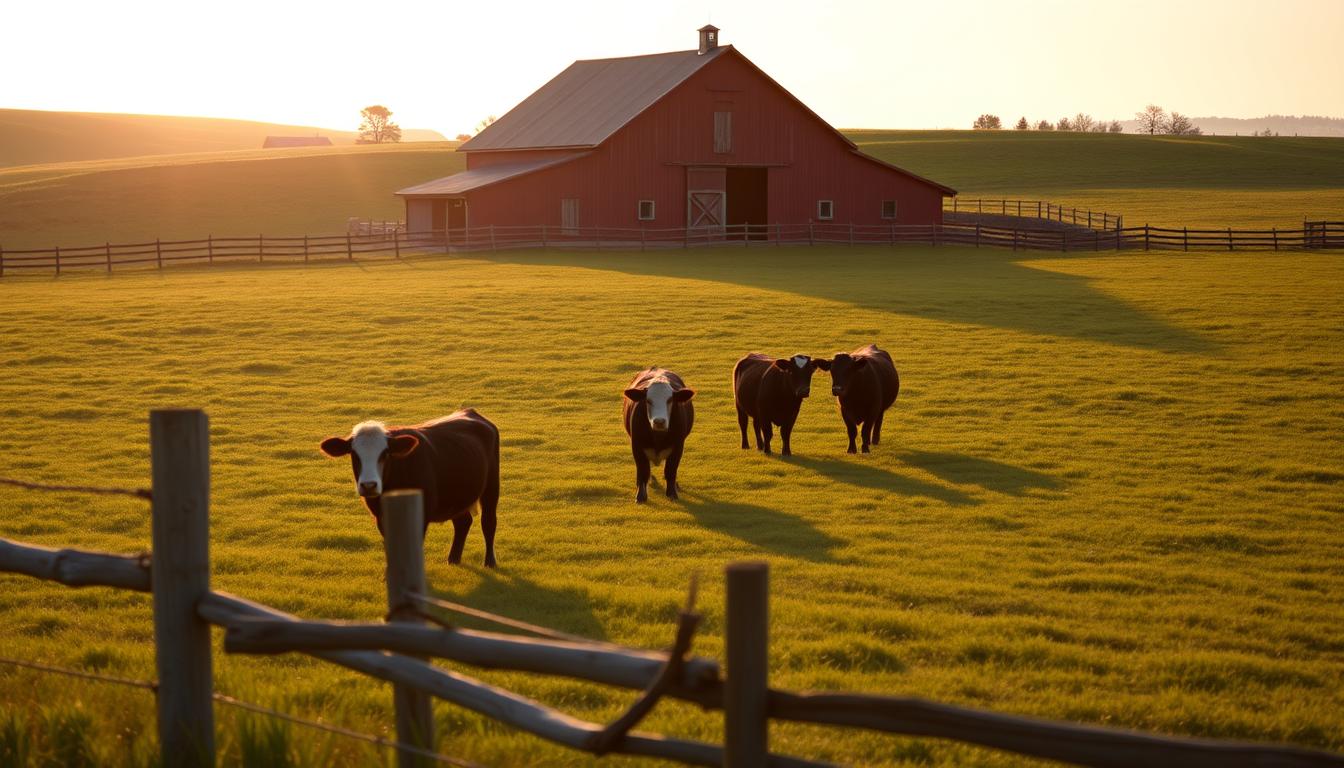
Dexter cattle are an integral part of sustainable livestock management due to their unique characteristics and benefits. They offer a versatile and environmentally friendly option for farmers looking to adopt more sustainable practices.
Rotational Grazing Practices
One of the key sustainable farming practices that Dexter cattle are well-suited for is rotational grazing. This method involves moving the cattle to different areas of pasture to allow the land to recover and maintain its fertility.
Rotational grazing not only improves the health of the pasture but also enhances the overall well-being of the cattle. By providing them with fresh grazing areas, it reduces the risk of parasite buildup and promotes better nutrition.
Environmental Benefits
The environmental benefits of raising Dexter cattle are numerous. Their small size and gentle grazing habits make them ideal for maintaining diverse and healthy ecosystems.
- They help in maintaining soil quality through their grazing activities.
- Dexter cattle promote biodiversity by allowing a variety of flora to coexist.
- Their manure acts as a natural fertilizer, reducing the need for synthetic fertilizers.
Integration with Other Farm Systems
Dexter cattle can be easily integrated into various farm systems, making them a valuable component of a diverse agricultural operation.
They can be used in conjunction with other livestock or crops to create a more resilient and productive farm. For example, they can be used to graze cover crops, helping to manage weeds and improve soil health.
Carbon Footprint Advantages
Raising Dexter cattle can contribute to a reduction in carbon footprint. Their efficient grazing habits and the ability to thrive on a variety of feed sources mean that they can be raised with minimal external inputs.
This not only reduces the carbon emissions associated with their care but also promotes more sustainable agricultural practices overall.
Economic Benefits of Raising Dexter Cattle

The profitability of Dexter cattle farming stems from their efficient production capabilities and the potential for creating value-added products. This breed offers a unique combination of cost-effectiveness and versatility, making it an attractive choice for small-scale farmers.
Cost-Benefit Analysis
Conducting a thorough cost-benefit analysis is crucial for understanding the economic viability of raising Dexter cattle. The initial investment includes purchasing quality breeding stock, fencing, and basic equipment. However, the ongoing costs are relatively low due to the breed’s hardiness and ability to thrive on minimal inputs.
Key benefits include the production of high-quality milk and beef, which can be sold directly to consumers or used to create value-added products. This diversification of income streams enhances the overall profitability of the farm.
Multiple Income Streams
Dexter cattle provide multiple income streams through the sale of milk, beef, and breeding stock. Farmers can also capitalize on the growing demand for artisanal dairy products and grass-fed beef by creating value-added products such as cheese, butter, and jerky.
- Sale of milk and dairy products
- Beef sales
- Breeding stock sales
- Value-added products
Marketing to Specialty Markets
Marketing Dexter cattle products to specialty markets can significantly enhance profitability. Consumers are increasingly seeking out products from heritage breeds and sustainable farming practices. By targeting these niche markets, farmers can command premium prices for their products.
Effective marketing strategies include highlighting the unique characteristics of Dexter cattle, such as their rich milk and tender beef, and emphasizing the sustainable and humane farming practices employed.
Value-Added Products
Creating value-added products is a key strategy for maximizing the economic benefits of raising Dexter cattle. Products such as artisanal cheeses, yogurts, and beef jerky can be sold at a significant markup compared to raw milk and beef.
By diversifying product offerings and targeting specialty markets, farmers can build a loyal customer base and achieve a competitive edge in the market.
Common Challenges and Solutions in Raising Dexters

While Dexter cattle offer many advantages, they also present challenges that require careful management and planning. Farmers and breeders must be aware of these potential issues to ensure the health and success of their Dexter cattle operation.
Health Issues Specific to the Breed
Dexter cattle are generally considered a hardy breed, but like all cattle, they can be susceptible to certain health issues. One of the primary health concerns is their propensity for calving difficulties due to their compact size and the relatively large size of their calves. To mitigate this, breeders should focus on selecting breeding stock with a history of easy calving.
Another health issue is the risk of genetic disorders, which can be more prevalent in smaller gene pools. Regular veterinary check-ups and genetic testing can help identify potential issues early on.
Handling Difficult Behaviors
Dexter cattle are known for their friendly and docile nature, but individual animals can still exhibit challenging behaviors. Training and handling practices play a crucial role in managing these behaviors. Consistent, gentle handling from an early age can help minimize aggression and fear-based behaviors.
It’s also important to understand the herd dynamics and ensure that the cattle are not too isolated or stressed, as this can lead to behavioral problems. Providing adequate space and social interaction within the herd can help maintain a calm and manageable group.
Overcoming Marketing Challenges
One of the marketing challenges faced by Dexter cattle breeders is the relatively small size of the market for this specific breed. To overcome this, breeders can focus on niche marketing, highlighting the unique qualities of Dexter cattle and their products, such as the rich flavor of their beef or the nutritional benefits of their milk.
Building a strong brand and engaging with potential customers through social media and local farmers’ markets can also help increase visibility and demand for Dexter cattle products.
Genetic Concerns and Management
Maintaining genetic diversity is crucial for the long-term health and viability of any cattle breed, including Dexters. Breeders should be aware of the potential for genetic bottlenecks and work to maintain a diverse gene pool.
Participating in breed associations and using resources such as pedigree analysis can help breeders make informed decisions about breeding stock and avoid inbreeding. Collaborating with other breeders can also help expand the gene pool and reduce the risk of genetic disorders.
The Future of Dexter Cattle in Modern Livestock Farming
Dexter cattle have a promising future in modern farming due to their unique characteristics, versatility, and potential for sustainable livestock management. As a heritage cattle breed, they offer a valuable opportunity for farmers to diversify their operations and capitalize on the growing demand for specialty beef and dairy products.
The future of Dexter cattle is closely tied to the adoption of modern farming practices that prioritize sustainability and environmental stewardship. By integrating Dexter cattle into rotational grazing systems, farmers can improve soil health, reduce erosion, and promote biodiversity.
With their compact size, hardiness, and dual-purpose capabilities, Dexter cattle are an attractive option for small-scale farmers and homesteaders. As the agricultural industry continues to evolve, the role of Dexter cattle in sustainable livestock management is likely to become increasingly important.
By embracing the potential of Dexter cattle, farmers can contribute to a more sustainable food system while also benefiting from the economic advantages of raising this heritage breed.
FAQ
What is the origin of Dexter cattle?
Dexter cattle originated in Ireland, specifically in the south, where they were bred as a hardy, dual-purpose cattle breed.
What are the characteristics of Dexter cattle?
Dexter cattle are known for their compact size, hardiness, and dual-purpose benefits, making them suitable for both milk and beef production.
How big are Dexter cattle?
Dexter cattle are a small breed, with mature cows typically weighing between 600-1000 pounds and standing between 36-44 inches tall at the hip.
What are the different colors of Dexter cattle?
Dexter cattle come in three main colors: black, red, and dun, with various shades and combinations within these colors.
Are Dexter cattle suitable for small farms?
Yes, Dexter cattle are well-suited for small farms due to their compact size, hardiness, and low maintenance requirements.
Can Dexter cattle be used for dairy production?
Yes, Dexter cattle are a dual-purpose breed, and their milk is rich in butterfat, making it suitable for dairy production, including cheese and butter.
How do I care for Dexter cattle?
Dexter cattle require regular feeding, shelter, and health monitoring, as well as proper fencing and management to thrive.
What are the benefits of rotational grazing with Dexter cattle?
Rotational grazing with Dexter cattle can improve soil health, reduce erosion, and promote biodiversity, while also improving cattle health.
Can Dexter cattle be raised for beef?
Yes, Dexter cattle are often raised for their high-quality beef, which is known for its tenderness and rich flavor.
How do I market Dexter beef and dairy products?
Marketing Dexter beef and dairy products can be done through various channels, including specialty markets, farm-to-table programs, and online sales.
What are the economic benefits of raising Dexter cattle?
Raising Dexter cattle can provide multiple income streams through the sale of beef, dairy products, and breeding stock, making them a profitable choice for small farms.
Are there any health issues specific to Dexter cattle?
Dexter cattle are generally a hardy breed, but they can be prone to certain health issues, such as chondrodysplasia, which can be managed with proper breeding and care.
How do I handle difficult behaviors in Dexter cattle?
Handling difficult behaviors in Dexter cattle requires patience, consistency, and proper training, as well as understanding the underlying causes of the behavior.
Conclusion of: Dexter Cattle | Small But Mighty Heritage Breed
Dexter cattle are a remarkable heritage breed celebrated for their versatility, manageable size, and adaptability to diverse agricultural settings. Originating in Ireland, Dexters have become increasingly popular among American farmers, particularly small-scale homesteaders, due to their efficient performance in both dairy and beef production.
What Are Dexter Cattle?
Dexter cattle are small-sized cattle characterized by their compact frame and gentle disposition. Standing approximately 36-44 inches tall and weighing between 600-1000 pounds at maturity, they’re the smallest naturally developed cattle breed in the world. Dexter cattle’s dual-purpose capabilities allow farmers to raise them effectively for both beef and milk.
Learn more at Oklahoma State University Extension
Historical Origin of Dexter Cattle
Originating from Ireland in the early 19th century, Dexter cattle are named after Mr. Dexter, a noted cattle breeder. Brought to America in the early 20th century, the breed gained favor among farmers looking for efficient, versatile livestock suited to limited acreage.
Read Dexter cattle history at American Dexter Cattle Association
Physical Characteristics of Dexter Cattle
Dexter cattle display distinct physical features, including short legs, sturdy frames, and three common colors: black, red, and dun. Their smaller size enables easier handling, lower feeding costs, and efficient pasture utilization.
Explore breed traits at Livestock Conservancy
Dexter Cattle Milk Production and Quality
The milk produced by Dexter cattle is renowned for its high butterfat content (up to 4-5%), making it excellent for cheese, butter, and yogurt production. Their moderate milk yield is highly valued on small farms and homesteads.
Milk quality facts at Dexter Cattle Society UK
Dexter Beef Characteristics
Despite their size, Dexter cattle produce beef that is exceptionally tender and flavorful, often commanding premium market prices. Dexter beef is naturally lean yet well-marbled, making it ideal for health-conscious consumers.
Dexter beef insights at Countryside Magazine
Economic Advantages of Dexter Cattle Farming
Dexter cattle farming offers considerable economic benefits, including lower feed and veterinary costs, high-quality product yields, and strong market demand. Their dual-purpose nature allows farmers to diversify their income streams effectively.
Economics discussed at University of Nebraska-Lincoln Extension
Nutrition and Feeding Requirements
Dexter cattle thrive primarily on quality grass or hay, supplemented by mineral and vitamin mixes when necessary. Their efficient metabolism allows them to maintain health and productivity on minimal supplemental feeding, ideal for pasture-based systems.
Nutritional management guidance at Penn State Extension
Health Management for Dexter Cattle
Although hardy, Dexter cattle require regular health management, including vaccination, parasite control, and hoof care. Their robust constitution generally results in fewer health problems compared to larger breeds.
Health tips at University of Missouri Extension
Breeding and Genetic Considerations
Selective breeding practices are crucial to maintaining the genetic health of Dexter cattle, especially regarding dwarfism (chondrodysplasia). Responsible breeding programs help maintain healthy, productive herds.
Genetic management at American Dexter Cattle Association
Environmental Sustainability with Dexter Cattle
Dexter cattle have a smaller ecological footprint due to their size and efficient grazing, ideal for sustainable agriculture. Their grazing habits enhance soil health and pasture longevity, beneficial for regenerative farming practices.
Sustainable practices at Sustainable Agriculture Research & Education (SARE)
Pros of Dexter Cattle Farming
Benefits of raising Dexter cattle include:
- Efficient use of pasture
- Excellent meat and milk quality
- Manageable size for small farms
- Calm temperament ideal for family farms
Benefits explored at Texas A&M AgriLife Extension
Cons of Dexter Cattle Farming
Challenges to consider:
- Limited beef volume compared to larger breeds
- Potential genetic issues without careful breeding
- Moderate milk production might not suit large-scale dairy operations
Management advice at Livestock Conservancy
Crossbreeding Opportunities
Crossbreeding with larger breeds can enhance beef yield and hybrid vigor, combining the Dexter’s advantages with higher productivity breeds, offering farmers diverse market opportunities.
Crossbreeding info at Iowa State University Extension
Final Thought
Raising Dexter cattle offers small-scale farmers an opportunity to achieve economic stability and sustainability. With their dual-purpose nature, adaptability, and efficient productivity, Dexters are a wise investment for sustainable agriculture and profitable farming.

